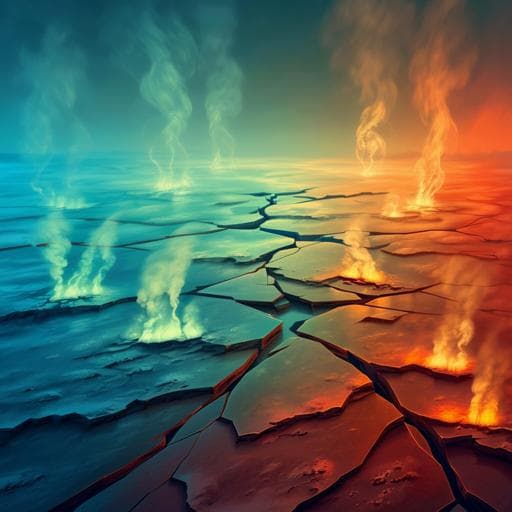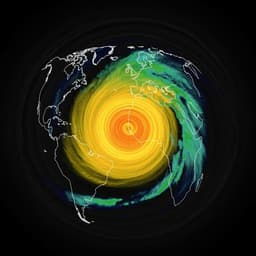
Earth Sciences
Abrupt increase in Arctic-Subarctic wildfires caused by future permafrost thaw
I. Kim, A. Timmermann, et al.
Discover how climate change is leading to a rapid thaw of Arctic-Subarctic permafrost, which may trigger intensified wildfires by the late 21st century. This groundbreaking research by In-Won Kim, Axel Timmermann, Ji-Eun Kim, Keith B. Rodgers, Sun-Seon Lee, Hanna Lee, and William R. Wieder reveals shocking insights into the consequences of permafrost thaw on future wildfires in western Siberia and Canada.
~3 min • Beginner • English
Introduction
The study investigates how rapid permafrost thaw driven by 21st-century greenhouse warming may trigger abrupt regime shifts in soil hydrology and, in turn, intensify Arctic-Subarctic wildfires. While the Arctic has historically experienced long fire return intervals, recent warm and dry summers have produced notable fire events, and fires in carbon-rich high-latitude soils can burn for months, releasing aerosols and carbon with climate impacts. Fire occurrence depends on atmospheric fire weather, soil water conditions, and fuel availability. High-latitude soil moisture responds to precipitation, evapotranspiration, snow/ice melt, and runoff, with permafrost acting as a barrier to drainage. Observations already show permafrost thaw and in some regions abrupt shifts that alter hydrology. However, fully coupled assessments linking permafrost, soil hydrology, land–atmosphere interactions, and wildfire dynamics in Earth system models have been limited. This work uses CESM2 large ensemble simulations to elucidate mechanisms that connect rapid permafrost thaw to abrupt soil drying, atmospheric changes, and wildfire regime shifts across the Arctic-Subarctic, focusing on western Siberia and Canada.
Literature Review
Prior work has documented increasing Arctic fire activity with warming and highlighted the role of soil moisture and hydrology in controlling fires. CMIP6 ESMs show a wide range of permafrost representations; only a small subset (13 of 134) includes explicit coupling between permafrost, soil hydrology, and fires. Earlier studies identified potential abrupt increases in fire severity with permafrost degradation using meteorological fire weather indices (FWI) that do not explicitly include soil hydrology or vegetation fuel changes. Observations indicate permafrost thaw is underway, with abrupt shifts in some regions affecting hydrology and surface water bodies. Field experiments over permafrost sites show that drainage-induced drying increases sensible heat and reduces latent heat in summer, suggesting a pathway for land–atmosphere feedbacks. Nevertheless, a comprehensive, fully coupled model assessment quantifying how permafrost thaw-induced soil drying affects wildfire behavior across the Arctic-Subarctic has been lacking, motivating the present study.
Methodology
Modeling framework: The study uses the ICCP/NCAR CESM2 Large Ensemble (CESM2-LE), with 50 members forced by historical (1850–2014) and SSP3-7.0 (2015–2100) scenarios. The land model is CLM5, which includes permafrost-related soil thermal and hydrologic dynamics, carbon cycle processes, and a process-based fire parameterization that represents ignition (climatological lightning and human-caused), fire occurrence and spread, and fire impacts.
Observations/reanalysis for evaluation: Burned area and biomass burning emissions from GFEDv4 (1997–2021), active layer thickness (ALT) and ground temperature from ESA CCI Permafrost (1997–2019), observed ALT from CALM (1997–2014), and 2 m air temperature from ERA5 (1997–2019) were used to evaluate trends and model realism over recent decades.
Detection of abrupt changes: For each ensemble member, change point analysis (R package strucchange) was applied to time series of ALT, soil ice content, soil moisture, sub-surface runoff, and burned area over 1850–2100. Abruptness timing maps and magnitudes were computed using 20-year pre- vs. post-change windows, and ensemble median characteristics were used for robustness.
Focus regions and variables: Analyses emphasized historical permafrost regions, especially western Siberia, far eastern Siberia, and Canada. A representative grid cell in western Siberia (65.5°N, 83.75°E) was used for detailed vertical and temporal diagnostics. Variables included ALT, soil temperatures by depth, soil ice content, soil moisture (e.g., 0–10 cm; 0–2 m; >3 m), runoff components, evapotranspiration, Bowen ratio, surface air temperature, relative humidity at 2 m, latent and sensible heat fluxes, ground heat flux, precipitation partitioning, and wildfire metrics (fire counts and burned area).
Idealized soil moisture perturbation experiments: Two CESM2 experiments reduced soil moisture north of 40°N by 20% and 40%, respectively, to isolate land–atmosphere and wildfire responses. July conditions were analyzed in Year 0 (2045-relative experiment setup) for differences from a control simulation, focusing on surface air temperature, relative humidity, energy fluxes, and burned area responses at the western Siberia site and across the region.
Carbon and lightning proxies: The study quantified cumulative carbon emissions from wildfires and net ecosystem exchange (NEE) over regions experiencing abrupt thaw and wildfire increases. Changes in convective available potential energy (CAPE) were used as a proxy for potential lightning changes relevant to ignition.
Model caveats: CESM2-LE employs fixed climatological lightning and is concentration-driven (fire emissions do not affect atmospheric radiation), which informs interpretation of wildfire projections.
Key Findings
- Rapid permafrost thaw timing and location: Abrupt changes in ALT and soil ice content emerge mainly over western Siberia, far eastern Siberia, and Canada from the mid-to-late 21st century.
- Magnitudes at a representative western Siberia grid cell (65.5°N, 83.75°E): ALT increases abruptly from 0.93 m (2040) to 4.09 m (2060); soil ice declines from 668 to 149 kg/m² over 2040–2060; near-surface soil moisture (0–2 m) drops by ~28% (2040: 71.1±2.9 kg/m²; 2060: 51.4±3.5 kg/m²).
- Vertical transitions: Soil temperatures in upper layers exceed 0°C by ~2030; warming propagates to 1–3 m with 0°C reached by ~2050. Deeper soil ice then melts, increasing vertical hydraulic conductivity, which enhances percolation and abruptly dries upper soils while increasing deeper soil moisture (>3 m).
- Hydrology: Sub-surface runoff exhibits abrupt shifts coincident with soil ice melt; surface runoff and surface water storage decrease after ~2050 due to soil moisture depletion. Precipitation increases monotonically without abrupt changes at thaw timing, indicating soil-hydrologic controls rather than precipitation shocks.
- Land–atmosphere coupling in summer (July/August): Following abrupt soil drying, evapotranspiration decreases and Bowen ratio increases over western Siberia and Canada. Surface air temperature rises by >2°C and relative humidity declines. At the western Siberia site, latent heat drops (2040: 66.9±14.1 to 2060: 50.7±10.3 W/m²), sensible heat rises (16.8±8.7 to 44.4±10.4 W/m²), ground heat flux decreases (28.4±5.8 to 21.3±5.1 W/m²), surface air temperature increases (15.4±3.0 to 18.5±2.8 °C), and RH falls (82.5±5.1% to 68.6±4.8%).
- Wildfires: Burned area after rapid thaw is ~2.6× pre-thaw levels across historical permafrost regions. At the western Siberia site, abrupt wildfire onset closely follows abrupt soil drying, with burned area ensemble mean reaching ~800 km² by 2100; fire counts and burned area increase and variability expands toward century’s end. Regions without abrupt soil ice/moisture change do not show abrupt wildfire increases.
- Idealized soil moisture reduction experiments: A 40% soil moisture reduction poleward of 40°N produces July surface warming >5°C and strong RH declines over western Siberia and Canada, driven by increased sensible and reduced latent heat fluxes. Burned area response is highly nonlinear (western Siberia, Year 0 July: 20% reduction ~0.25 km² vs. 40% reduction ~92.5 km²). Soil moisture recovers slowly, prolonging elevated fire risk.
- Lightning proxy: CAPE increases by ~50% in June over key regions by 2081–2100, implying potential increases in lightning ignitions beyond those explicitly represented, suggesting further wildfire amplification.
- Carbon implications: Cumulative wildfire carbon emissions over abruptly changing permafrost-fire regions reach 322.6±74.7 TgC by 2100; cumulative NEE is ~8.9±256.5 TgC. Fire-driven carbon release accelerates after mid-century, though represents a relatively small share of total high-latitude terrestrial carbon fluxes.
Discussion
The analyses demonstrate that rapid permafrost thaw in ice-rich Arctic-Subarctic regions precipitates abrupt hydrological regime shifts—particularly increased permeability and percolation that quickly dry upper soils. This abrupt soil moisture loss reduces ground evaporation, increases the Bowen ratio, and amplifies sensible heat flux to the atmosphere, leading to rapid surface warming and atmospheric drying in summer. These land–atmosphere feedbacks create conducive fire weather and fuel conditions, driving an abrupt transition to a higher-wildfire regime, especially in western Siberia and Canada. The findings provide a mechanistic link connecting permafrost thaw, soil hydrology, and wildfire dynamics, moving beyond meteorological indices to a fully coupled process representation. Idealized soil moisture reduction experiments corroborate the causal role of soil moisture in controlling surface energy partitioning, near-surface climate, and fire activity, and highlight nonlinear wildfire responses to drying. Projections also suggest that increases in convective potential (CAPE) may enhance lightning ignitions, compounding thaw-driven wildfire risks. While wildfire emissions increase and accelerate net carbon release in affected regions after mid-century, their contribution remains modest relative to total permafrost-region carbon fluxes. Overall, the work underscores permafrost thaw as a catalyst for abrupt wildfire regime shifts through coupled soil-hydrology–atmosphere processes.
Conclusion
This study shows that future rapid permafrost thaw can trigger abrupt upper-soil drying, intensify summer atmospheric warming and aridity, and cause a nonlinear increase in Arctic-Subarctic wildfires, particularly over western Siberia and Canada. By leveraging a 50-member CESM2 large ensemble and idealized soil moisture perturbations, the study quantifies timing, magnitudes, and mechanisms linking thaw to fire regimes, and provides estimates of associated carbon emissions. Future research should: (i) improve representation of ground subsidence and thermokarst processes, (ii) include lateral water flows and landscape connectivity in soil hydrology, (iii) enable climate interactions with CO2 and aerosol emissions from fires in prognostic ESM frameworks, (iv) incorporate lightning parameterizations that evolve with climate (e.g., CAPE-linked), (v) allow more realistic vegetation demographic transitions affecting fuels, and (vi) capture feedbacks of fire thermal properties on permafrost thaw. Incorporating these advances will refine projections of coupled climate–hydrology–fire–carbon interactions in high latitudes.
Limitations
- Subgrid permafrost processes are parameterized; abrupt post-thaw drying may oversimplify diverse, scale-dependent geomorphic and hydrologic responses (e.g., polygonal terrain, thermokarst, subsidence-induced inundation).
- The model underestimates observed burned area at high latitudes and uses fixed climatological lightning (no internal lightning variability), potentially underrepresenting ignition changes and future lightning increases.
- Concentration-driven setup means wildfire CO2/aerosol emissions do not interact radiatively with the atmosphere in the simulations.
- Lack of explicit representation of lateral hydrological flows and watershed connectivity may bias local moisture and runoff responses.
- Vegetation demographic processes and potential biome transitions are simplified, affecting fuel dynamics.
- Results may differ with newer parameterizations that include thaw subsidence and dynamic inundation, which can either increase or decrease soil saturation depending on local drainage conditions.
Related Publications
Explore these studies to deepen your understanding of the subject.







